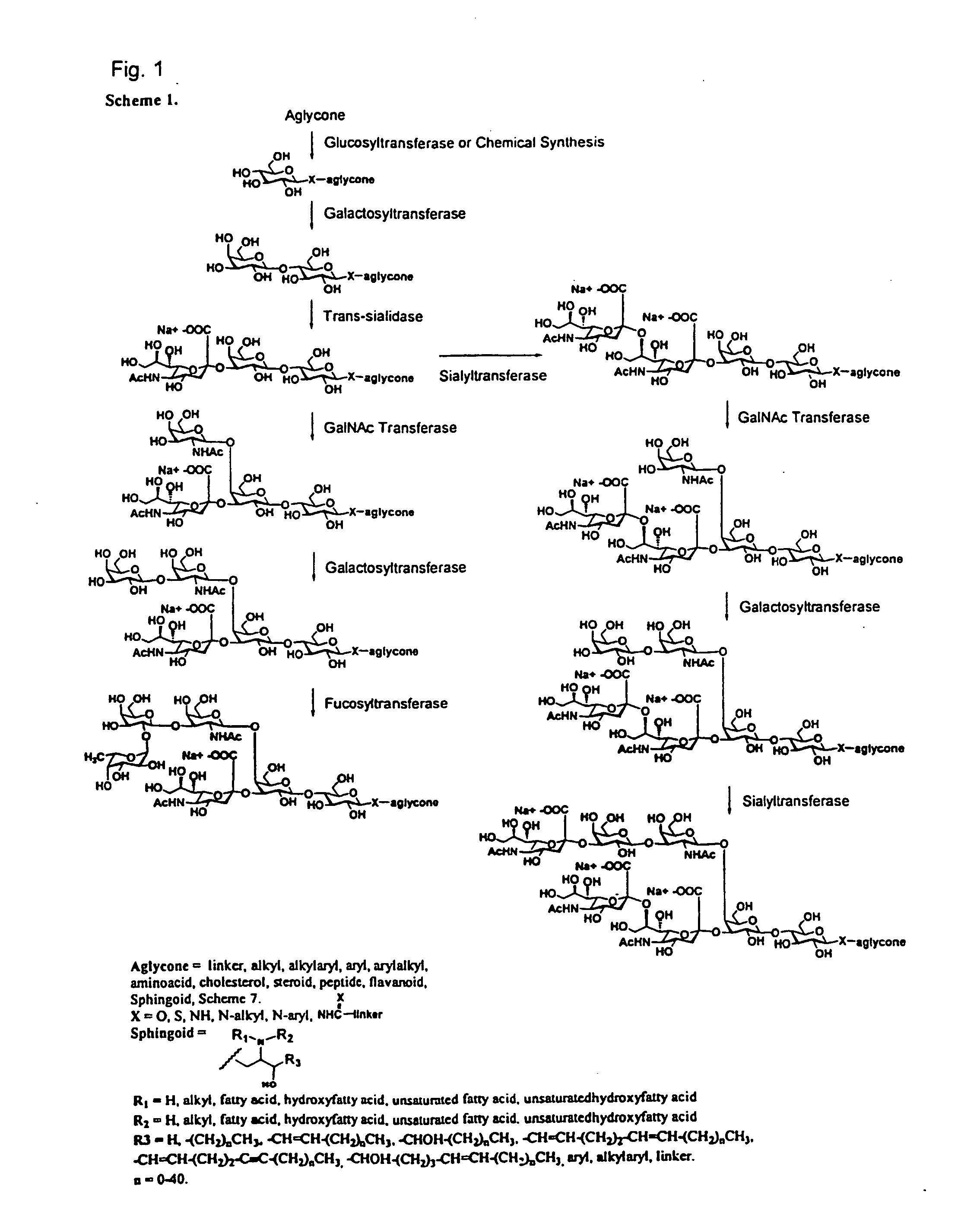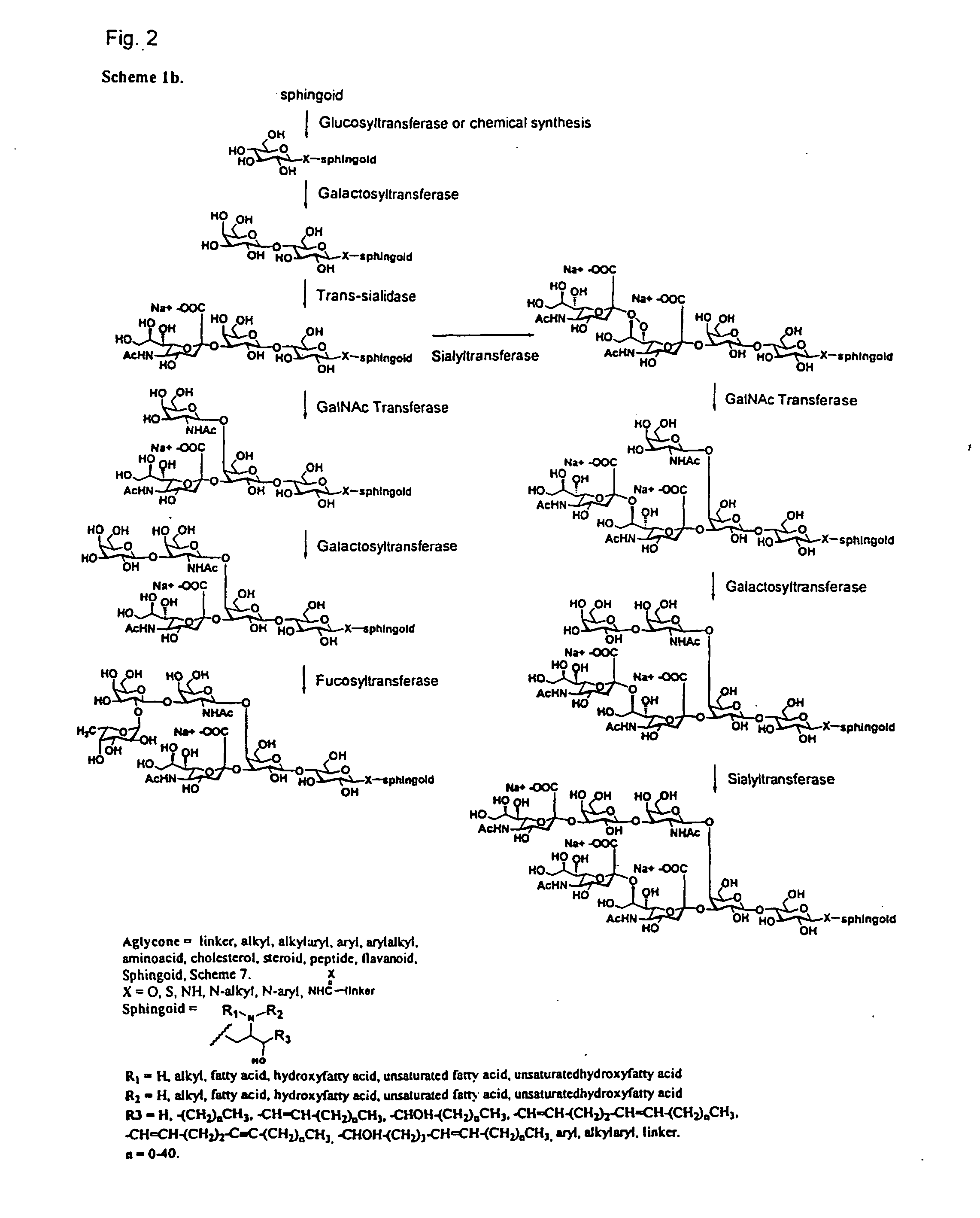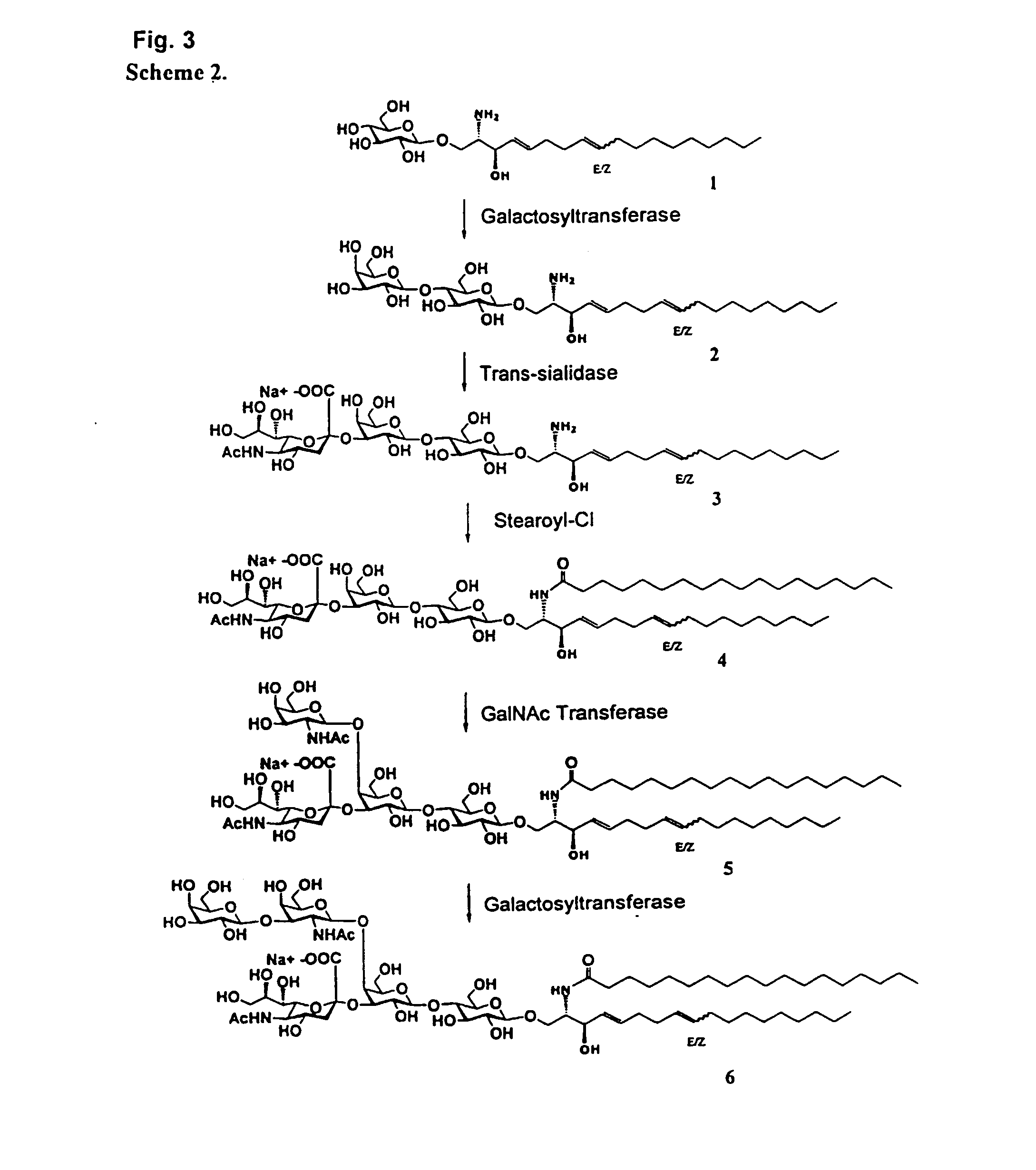Chemo-enzymatic synthesis of sialylated oligosaccharides
- Summary
- Abstract
- Description
- Claims
- Application Information
AI Technical Summary
Benefits of technology
Problems solved by technology
Method used
Image
Examples
example 1
Synthesis of Lactosyl Ceramide and GM3
Lactosyl Ceramide (d18:2) (7). Lactosyl sphingosine (2.2 g) was dissolved in 110 mL of a solution containing chloroform-methanol-40 mM phosphate buffer (pH=7.2) (60 / 40 / 9). The N-hydroxysuccinimide stearate (13.2 g) suspended in chloroform (55 mL) and triethylamine (1.1 mL) were then added and the reaction stirred at room temperature overnight. The solution was concentrated to dryness and the residue resuspended in acetone (110 mL). A methanolic solution of 10% magnesium chloride (11 mL) was then added and the solution cooled with dry ice for 1 hour. The precipitate was filtered and washed with cold acetone yielding 3.2 g of lactosyl ceramide (7) as a white solid. HPLC (Metachem Inertsil C8 column; 85% acetonitrile / 15% water, UV 205 nm), Rt=23.1 min. See, Scheme 3. Additional variations in the protocol to synthesize lactosyl ceramide are shown in Table 2.
TABLE 2Synthesis of Lactosyl CeramideAmount ofcompound 7SolventReaction TimeLactosyl cera...
example 2
Synthesis of GM3, GM2, and GM1
Lactosyl Sphingadienine (d18:2) (2). (See, Scheme 2) The glucosyl sphingadienine (d18:2) (1) (0.50 mM, 6.8 g), HEPES (20 mM, 141 g), MnSO4 (50 mM, 2.5 gm), UDP-galactose (4.0 mM, 76.7 g), NaN3 (160 mM, 5.92 g) and water (30 L) were added to the reactor. The pH of the solution was adjusted to 7.4 and was maintained between 7.0-7.5. The β1,4-galactosyltransferase (900 units) was then added to the reaction mixture and the solution stirred for 12 hours yielding 7.1 gm of lactosyl sphingadienine (d18:2) (2) as determined by HPLC analysis. TLC (silica gel; CHCl3 / CH3OH / H2O / 2.5 M NH4OH-60 / 40 / 5 / 3), Rf=0.67; HPLC (YMC basic column; acetonitrile / sodium phosphate buffer (10 mM, pH 6.5); gradient of 30% to 80% acetonitrile; UV 205 nm), Rt=11.13 min and 11.48 min. MS (electrospray), m / z 620.2 [M−H]−.
Lyso-GM3 (d18:2) (3). The 3′-sialyllactose (16 mM, 388.8 g) and Zwittergent (61 mM, 22.5 g) were added to the above reaction mixture and the reaction volume adjusted ...
example 3
Synthesis of GD3 (See, Scheme 9, Top Reaction GM3 (22)+Sialyltransferase and Sia Donor, Yields GD3 (35))
GD3 (d18:1) (35). Zwittergent (0.05 mg; 0.1%) was added to a methanolic solution of GM3 (d18:1) (500 μM; 0.032 mg) and the solution evaporated with a stream of N2 gas. —HEPES (50 mM, pH 7.0), CMP-sialic acid (0.02 mg), 10% cell lysate containing α-2,8-sialyltransferase-CST-68 (5 μL), MgCl2 (10 mM; 0-1 mg), and water to a final reaction volume of 50 μL were then added. The reaction is incubated at 37° C. and for 3 hours. The sialylated products were purified using a Waters C18 Sep-pak light cartridge. The eluant was evaporated to dryness providing a mixture of GD3, GT3 and other multisialylated forms of GM3. The percent conversion as calculated by HPLC as area %: GM3, 39%; GD3 38%; GT3, 15%; GQ3, 7%. HPLC-MS (YMC basic column-4.6×100 mm; eluted with a gradient of 1 mM aqueous NH4OH and acetonitrile from 50 to 95% MeCN over 8 min at 0.265 mUmin; UV=205 nn), GM3 (ret time=29.54 min...
PUM
| Property | Measurement | Unit |
|---|---|---|
| Angle | aaaaa | aaaaa |
| Molar density | aaaaa | aaaaa |
| Molar density | aaaaa | aaaaa |
Abstract
Description
Claims
Application Information
 Login to View More
Login to View More - R&D
- Intellectual Property
- Life Sciences
- Materials
- Tech Scout
- Unparalleled Data Quality
- Higher Quality Content
- 60% Fewer Hallucinations
Browse by: Latest US Patents, China's latest patents, Technical Efficacy Thesaurus, Application Domain, Technology Topic, Popular Technical Reports.
© 2025 PatSnap. All rights reserved.Legal|Privacy policy|Modern Slavery Act Transparency Statement|Sitemap|About US| Contact US: help@patsnap.com



